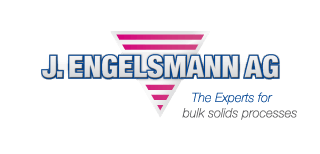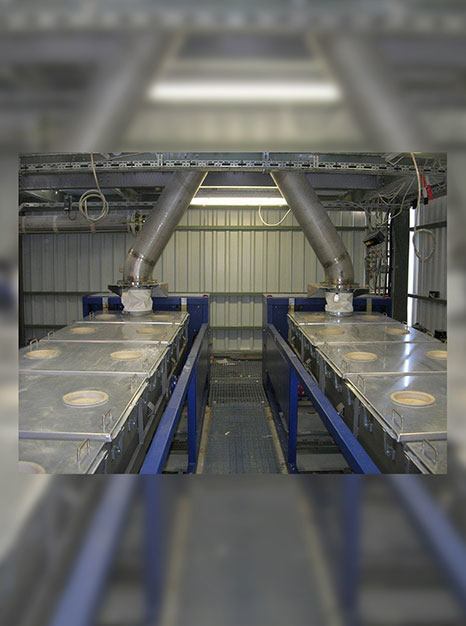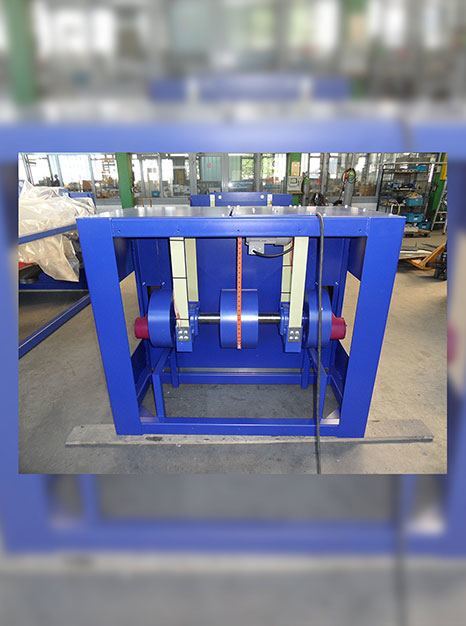Dust-Proof Classifying of PVC: Getting the Screening Process Going
PVC is a valuable resource because of the wide spectrum of applications in which it can be used and its cost-effective procurement. The production processes employed to produce the raw PVC material need to be correspondingly economical. One of the manufacturing processes involved when producing PVC is the separation of oversized particles by means of mechanical sieving. When carrying out the process, the sievability of the raw material represents a significant challenge for the technology used, as a current project of the screening manufacturer J. Engelsmann AG demonstrates.
In particular the dust and particle characteristics of plastics in their primary form increase the difficulty of the sieving and put significant demands on the throughput, safety and cost-effectiveness of the machine. This is also what happened to a world-wide operating PVC manufacturer, who replaced his entire inventory of machines one-after-another after experiencing continuing problems when carrying out classification sieving of S-PVC at one of his production facilities in Scandinavia. The last of the long-stroke screening machines type Freischwinger were loaded and sent north from Ludwigshafen at the start of the year.
Complex sieving task: Problems with the classification of S-PVC
The chemical group that became aware of Engelsmann as a result of the contact established at a trade fair, manufactures S-PVC, among other products. The suspension process is used in 85% of the time when PVC is manufactured. The final product that results are PVC particles that only absorb a very limited amount of water and are extremely pure in their composition. The screening properties of PVC depends on the size of the particles, or, to be more exact, the diameter and its composition. Normally the separation of the oversized particles is carried out using the classification screen with mesh openings of 400 µm in order to sieve out unwanted agglomerate and over-sized particles. The correctly sized particles on the other hand pass through the mesh of the sieve fabric.
The problems which the PVC manufacturer has had with the machine being used up to now have been varied and have prevented a safe and economical sieving process from being carried out. A particularly important criteria required by the plastics manufacturer was that the sieving process would be guaranteed to be dust-proof in order to protect the surrounding environment from health-endangering dust particles. In the case of the screening machines present up to now, dust escaped time and time again when in operation. Also well up the wish list was an increase in both the productivity and cost-efficiency of the machine when in operation. This related to the attrition rate of spare parts as well as energy consumption and the level of effort and difficultly associated with carrying out maintenance on and cleaning the machines. The oiled gear motor of the screening machine in particular caused problems because oil from the drive motor leaked and soiled the ground underneath the machine time and time again, while the failure-prone anti-friction ball bearings resulted in the spare parts expenditure going through the roof. Coming on top of all those negatives, the motor when running was incredibly loud at in excess of 85 dB(A).
Free swinging screening machine separates selectively and absolutely dust-proof
Thanks to the comprehensive experience with complex sieving tasks, Engelsmann was aware of the problems associated with sieving of powdery and granulate-shaped PVC. Following extensive testing on the original product, the constructors at Engelsmann were certain that with the use of the long-stroke screening machine series Freischwinger, the problems being experienced by the PVC manufacturer would be solved. The free-swinging sieve was conceived at Engelsmann especially for the purpose of conducting economical classification of dried and free-flowing bulk materials. The Freischwinger model is used in all sectors of the chemical, pharmaceutical, plastics and food industries because of its high throughput of up to 250 tons an hour and because the classification is particularly gentle on the product with a selective separation rate of 98.5%.
In order to achieve the performance level of 12.5 tons of through-put an hour as demanded by the customer, the Freischwinger screening machine has been equipped with six sieve inserts arranged in a row, with an entire overall surface area of 3 square meters and a mesh width of 400 µm. Underneath the sieve fabric, a ball-bearing cleaning system is arranged on a corrugated grill which keeps the mesh fabric permeable during the sieving process. The individual screening surfaces are cleaned by bouncing rubber balls which are flung against the mesh fabric by the horizontal vibrations of the machine. The angle of the sieve can be altered and as a result the flowing speed of the PVC product, which in turn allows the amount of time the PVC product spends on the sieve fabric to be controlled. The Freischwinger is at an angle of 5° when delivered. This angle can be altered by ± 2 °.
Resource-saving operation thanks to oscillating drive
The Freischwinger screening machine with its weight of 850kg is equipped with a specially developed energy-efficient oscillating motor. The screening machine is driven by an electromotor which transfers its power via a fan-belt onto a flywheel equipped with an actuating rod, which in turn is exactly adjusted to the mass of the sieve trough. The powertrain (driveshaft and flywheel) weighs roughly the same amount as the trough and the product together. The motor propels the mass for roughly 15 seconds with full rated current and then maintains this momentum using a mere 10 to 20 percent of the rated current. This entails the electrical energy being transformed into rotational energy which is stored in the flywheel and then released gradually. Thanks to the mass-compensation drive, the machine requires only a limited amount of energy when operating (1,1 kW for 3 sqm of sieving surface area). In contrast to the screening machine with oiled gear motor employed up to now, the oscillating drive is subject to very little mechanical attrition, which in turn translates into less material being needed as well as far less maintenance work being required.
Changing the machine reduced operating costs by half
In order to keep down times to a minimum and to maximize the operational availability of the screening machine, it must be possible to exchange the sieve inserts quickly and easily. It is for this reason that the Freischwinger machine is equipped with a quick-exchange version. The trough cover is made of aluminum because of its limited weight and the cover is divided into a number of segments, each of which can be removed by hand enabling direct access to each of the individual sieve inserts without lifting equipment being required. The time required in comparison to a cover that would not be divided into a number of different segments is significantly reduced. After the parts of the cover have been removed, the standardized, and with pressure rail secured sieve inserts can be quickly exchanged individually using the integrated quick release. The spare parts in the interior of the machine can also be as easily accessed and exchanged. The sieve trough is closed securely and completely dust-proof with the quick-release fasteners and no dust particles can escape during the sieving process. In the case of seals which gradually settle into place, the cover tensioning levers adjust automatically. The sight window integrated into the cover allows the sieving process to be monitored.
The replacement of the existing screening machines with the four Freischwinger models in total has paid off for the chemical manufacturer in a number of different ways. Besides the dust-proof, and as a result, environmentally friendly sieving-off of oversized particles, the reduced downtimes resulting from reduced cleaning and maintenance requirements, in turn resulted in the increased availability of the machine and with that increased productivity. With the oscillating drive which requires far less energy, as well as maintenance and spare parts, operating costs were reduced by half. The Freischwinger machines as a result made the operating times of a three-shift cycle on 360 days a year wanted by the chemical manufacturers possible. The screening machines are however turned off, checked and serviced for one week at the request of the chemical manufacturer.
Properties at a glance Freischwinger PVC Screening Machine
- reduced energy consumption thanks to oscillating motor
- segmented trough cover
- dust-proof sieve trough
- limited maintenance and amount of spare parts required
- high selectivity (up to 98.5%)
- quiet running < 78 dB(A)
- long service life of the sieve fabric








